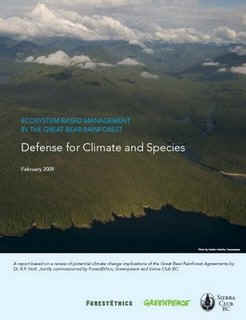
Straight.com, March 5, 2009
Great Bear Rainforest is a top carbon
storehouse that should be conserved
By Jens Wieting
B.C.’s coastal temperate rainforest is
one of the best carbon storehouses on the planet. These forests store up to
1,300 tonnes of carbon per hectare and continue to sequester carbon. Logging
old-growth forest releases up to 50 percent of its stored carbon into the
atmosphere. In the most productive stands of the Grreat Bear Rainforest and other coastal forests, keeping a single hectare of
forest intact rather than releasing the carbon through logging is the equivalent
of taking up to 450 cars off the road for a year. Reduced logging of ancient
forests is one of the most effective immediate actions we can take to reduce our
greenhouse-gas emissions.
If Premier Gordon Campbell follows through
with his internationally vaunted conservation commitment on the Great Bear
Rainforest, the avoided logging of prime temperate rainforest will prevent
around 150 million tonnes of carbon dioxide from being released into the
atmosphere. That is three times what the province emits annually from the use of
fossil fuels—or the equivalent of taking at least 28 million cars off the road
for a year. (That’s one and a half times the total number of cars in the whole
country.)
As with other ecosystems, stress from a
changing climate will take its toll on our coastal temperate rainforest. For
example, climate-change models reveal the disappearance of a climate suitable
for the survival of western red cedar along the outer coast of B.C. However, our
coastal rainforest has some natural advantages in the face of global warming. Temperature changes will be moderated by the region’s proximity
to the ocean. Where large intact tracts of old-growth forest still exist, as in
the Great Bear Rainforest, species will have a better chance to adapt or move in
order to adjust to the changing climate.
With this in mind, climate change sheds
new light on the agreements for the protection of the Great Bear Rainforest
announced by Premier Campbell three years ago, with the promise of
implementation by March 31, 2009. Significant progress has been made over the
past three years—but whether the premier is giving clear direction to his
ministers to make good on the commitments to conserve Great Bear Rainforest
ecosystems remains to be seen in the next few weeks. We think it is possible.
What has been secured so far is a network
of protected areas covering 2.1 million hectares and a $120-million fund to
support a conservation economy in First Nations territories, set up with funding
from private environmental donors, and the provincial and federal governments.
As the March 31 deadline fast approaches,
the provincial government must meet its commitment to implement lighter-touch
logging (based on ecosystem-based management) in the two-thirds of the Great
Bear Rainforest not protected. The science is clear that managing unprotected
areas with a much lighter touch is imperative; otherwise, the survival of this
spectacular rainforest and its species will be in real jeopardy. Under a
changing climate, it is particularly important that enough forest is left behind
for the ecosystem to adapt after logging. In the Great Bear Rainforest,
independent science has confirmed this means 70 percent of naturally occurring
old-growth forests must be maintained at all times. By following through on the
goal of ecosystem integrity and human well-being in the region, B.C. has an
important opportunity to lower its greenhouse-gas emissions while protecting
habitat for species like grizzly
and spirit bears, coastal wolves, and marbled murrelets.
Scientists predict extinction of 25
percent of the world’s species by 2050 due to global warming. In B.C., 43
percent of all species are already of conservation concern. The combination of
climate change, habitat loss due to industrial activity, and other pressures
will be fatal for many species in B.C. and elsewhere.
In order to ensure the survival of as many
species of animals and plants as possible, we must work with urgency towards two
goals: to protect more natural habitat to allow species as much space as
possible to adapt to a changing climate, and to reduce carbon-dioxide emissions
from all sources as quickly as possible to avoid catastrophic climate change.
Implementation of ecosystem-based management in the Great Bear Rainforest will
make an important contribution to achieving these goals.
We must act swiftly to reduce emissions
from burning fossil fuels and manage nature differently to maintain biological
richness and the carbon stored by ecosystems. Full implementation of the Great
Bear Rainforest agreements has the potential to become a model both for species
protection and fighting global warming. Premier Campbell can demonstrate his
commitment to tackling global warming and maintaining biological diversity by
creating a “model the world can learn from” in the Great Bear Rainforest by
March 31 and beyond.
Jens Wieting is the coastal forest
campaigner for the Sierra
Club B.C.
Read report
|